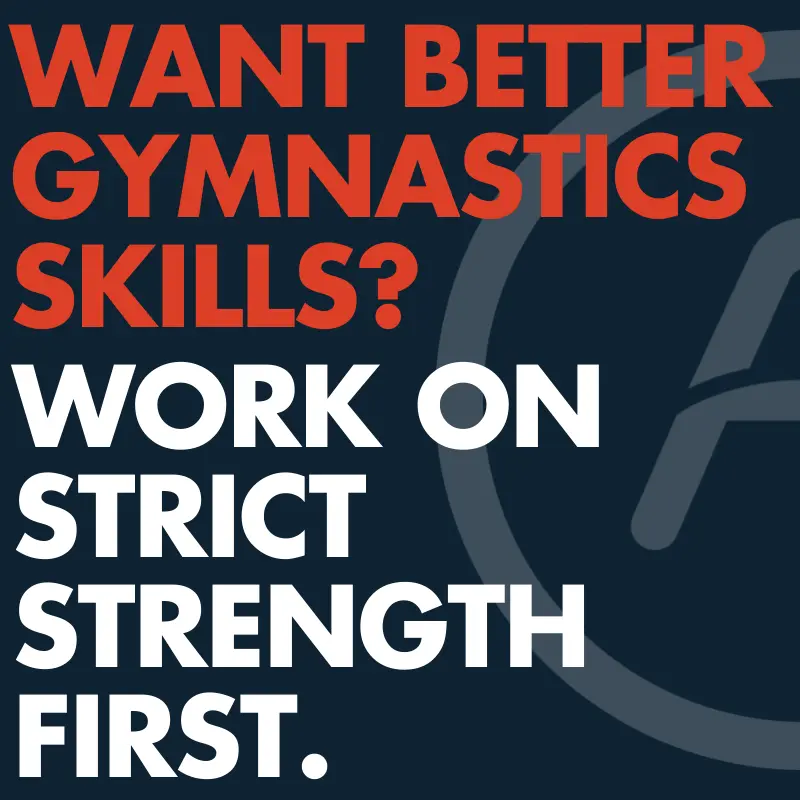How to progress your gymnastic skills
What you need to focus on first.
For any one of you who walks through our doors and takes our classes, an extremely important element that is necessary when it comes to your gymnastics skills is prerequisite strength.
In gymnastics, strength is essential. It will allow you to grow your ability and virtuosity (or mastery) of movement with any of the bodyweight movements. It will also help keep your body healthy and aid in injury prevention.
Working on skills prematurely, before having the prerequisite strength and control, will make your progression much slower and increase the chances of injury. There are no shortcuts with gymnastic movements. Skipping stages leads to bad training habits and frustration down the line.
We know it’s fun to learn new skills and try them in workouts, but doing so before your body is ready is not safe. We want to keep you healthy and moving towards your goals, not regressing. This is why we have strict standards when it comes to the use of kipping movements. In your development of skills, it is best to work on the strict strength progressions first, then add kipping once that strength has been developed. It does not work the opposite way.
As Jeff Tucker once said, “Strength and form before speed.”
This can apply to all movements that we perform, not just gymnastics.
How does one get injured when they are moving with speed before having the necessary strength and technique? When strength and control aren’t present, your body will search for other ways to disperse the forces being generated. Those forces are directed to the muscles and connective tissues, which are not prepared to handle them. This can lead to strains and tears of tendons and ligaments. Your muscles and tendons will handle the forces produced much easier if you have the prerequisite strength and form.
So with pull-ups, where do you start?
In the beginning, the first movement you need to focus on is the “active hang.” This is hanging from the pull-up bar while in a hollow-body position whilst also pulling down on the bar with straight elbows and lifting your body upward. Scap pull-ups are a great exercise for building strength in the shoulders and lats. You can also do active hangs, where you hold the top position for several seconds in a row.
Another skill you need for pull-ups is grip strength. The stronger the forearms and your grip, the more reps you will be able to perform. There are many ways to build it: farmer’s holds, passive hangs, DB wrist curls, or plate pinches are all great exercises.
After working on these skills, you will next want to build strength to perform the strict pull-up. A common method for doing this is doing banded pull-ups. We have gotten away from using these as they provide a lot of assistance in the bottom portion of the pull-up. If you don’t have pull-ups, this is not doing you any good. One reason you may be stuck on pull-ups is that you’ve only been doing them banded and haven’t built enough strength through the entire range of motion.
This is why we encourage the use of assisted pull-ups, whether you do them on the rig or the rings. These are a much better starting point to developing pull-up strength. This allows you to perform the movement through its entire range of motion while using your legs to assist you as you need it. This part is important, as you don’t want to be using your legs too much and making the movement easier than it needs to be. Performing these with a tempo will make them all the more challenging as well!
From here, you can progress to eccentric or negative pull-ups. This is where you start with your chin over the pull-up bar and slowly lower yourself to the bottom position, trying to go the same speed throughout. Ideally, the lowering takes 4-6 seconds. If you are unable to control the descent, you can also do these assisted with a box or on the rings.
When performing any of these movements, it is critical to prioritize quality over quantity. You will get much more out of a few perfect and controlled reps rather than “meh” reps at a higher volume.
Once the above movements have been mastered, you can then progress to doing strict pull-ups in a hollow position without any assistance. It may take some time to get to this point, so be patient and focus on getting strong and efficient in the above movements!
This methodology applies to all the gymnastic movements as well, not just pull-ups. If working on HSPU, you will want to work on mastering push-ups, pike push-ups, strict HSPU, and then kipping in that order. Same goes for TTB, you would want to follow the progression of active hangs, controlled kip swings, knee raises, leg raises, and then toes to bar.
When it comes to anything we do in the gym, you should always focus on building base strength for all movements before you attempt any dynamic movements. This will keep you safe, strong, and healthy! If you have any questions on this topic, please let us know!
